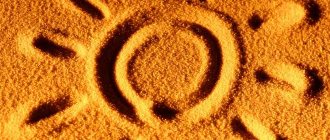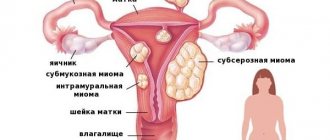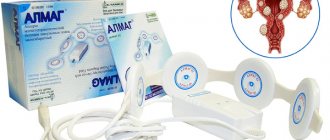The use of radon baths for uterine fibroids shows positive results. patients note a beneficial effect on the body in the form of reducing the growth rate of tumor formations, increasing the resistance of the immune system, normalizing metabolic processes and restoring the function of the endocrine apparatus.
Uterine fibroids are neoplasms of benign origin and are characteristic exclusively of the fairer sex. Being hormone-dependent, the tumor is able to respond to the slightest changes in the body. Therefore, some patients experience active growth of myomatous nodes, while in others they remain in one state for a long time. Treatment of uterine fibroids is carried out conservatively or surgically. Physiotherapeutic methods, which include radon therapy, are also actively used.
The benefits of balneotherapy for uterine fibroids
Balneotherapy is widely used in the treatment of various gynecological pathologies, including uterine fibroids. Radon exposure provides the best results.
Balneotherapy helps:
- normalize the patient’s menstrual cycle;
- reduce the concentration of estrogen in the blood;
- for pain syndrome;
- restore blood microcirculation;
- increase the body's nonspecific reactivity;
- normalize blood clotting indicators;
- speed up metabolic processes in the body;
- ensure correction of hormonal levels and stop the development of neoplasms.
It is advisable to carry out the procedures when the fibroids are small in size. In this case, physiotherapy in combination with hormonal therapy allows you to achieve confident results. The progress of the tumor stops and the tumor resolves.
Interesting! Physiotherapy services are provided by gynecological resorts and sanatoriums. A referral for treatment must be obtained from a doctor. He will determine the most convenient method of exposure, the required duration and frequency of the procedure.
Reviews
On the Internet you can find various reviews about the implementation of such treatment. Most patients are satisfied. They talk about how their fibroids were actively growing and a radon bath helped them cope with this disease. There are also negative opinions indicating the high cost and low effectiveness of the procedures. One way or another, every woman’s body is individual. For radon baths to be effective, certain conditions must be met and constant support from a gynecologist.
Svetlana, 48 years old: “I’ve never had problems with gynecology. With the onset of menopause, I underwent a routine examination and found out about fibroids. It's good that she turned out to be small. The doctor recommended me a course of radon therapy, and if that doesn’t help, then hormonal treatment. I was treated in a sanatorium for a month, and when I returned, I found out that the fibroids had significantly decreased in size.”
Lydia, 31 years old: “I have had fibroids for a long time, and it prevents me from bearing a child. Already 4 pregnancies ended in miscarriage. I tried everything - I drank hormones, herbs, and did yoga. A friend recommended radon baths to me, and I decided to take them. A month after the two-week course, I found out that I was pregnant and now everything is going well.”
Radon baths are used to treat diseases of the body, including the musculoskeletal system. It is not advisable to carry out procedures for the purpose of prevention.
Radon baths
Radon is a chemical element that is formed by the decay of radium. It has a short half-life and is quickly eliminated from the body. Treatment is carried out using alpha radiation, a stream of large positively charged particles with a flow of energy.
Radon acts directed, has a reflex and humoral effect. The drug acts on the neuro-reflex system due to its ability to settle in the form of an active layer on the patient’s body. The product stimulates the activity of protein compounds and water molecules in the skin.
Due to the stimulation of peripheral receptors, it provokes responses from internal organs and the bloodstream. The product penetrates the subcutaneous layers, dissolves in lipids and moves along with the bloodstream and lymph, reaching the desired organ. The elements stimulate the production of biologically active compounds and increase the permeability of certain receptors.
Radon baths are effective for fibroids; they help stop the process of tumor development and normalize the menstrual cycle. A similar effect is achieved by regulating hormonal levels and reducing the intensity of estrogen production. By its nature, radon is a toxic substance, but it is precisely due to this action that it stops the progress of the tumor.
How does radon affect a woman’s body?
To treat fibroids, modern medicine uses not only natural, but also artificial radon baths. The product has the following effects:
- anti-inflammatory;
- wound healing;
- immunostimulating;
- pain reliever;
- relaxing.
Already after the second procedure, noticeable changes in the patient’s well-being can be observed:
- the process of blood microcirculation is normalized;
- heart function is restored;
- the patency and elasticity of blood vessels improves;
- the functioning of the central nervous system is normalized;
- analgesic effect is achieved;
- accelerates metabolic processes;
- Optimal blood clotting parameters are achieved.
The procedure is recommended for women with fibroids, because radon really helps stop the progress of the tumor. The method is also used for endometriosis. By increasing blood clotting and normalizing the balance of hormones, uterine bleeding inherent in the pathology, leading to anemia, is eliminated.
Indications for use and effectiveness
The method can be used after a complete examination as prescribed by a gynecologist. The course of treatment is determined individually, taking into account medical history. When determining a treatment regimen, it is necessary to take into account the volume and type of tumor, as well as the nature of the surgical intervention. For the effect to be complete, the doctor must take into account the following factors:
- reproductive capabilities of the body;
- woman's age;
- intensity of clinical symptoms.
The list of main indications for visiting the procedure includes:
- heavy uterine bleeding;
- old fibroids;
- progressive nature of tumor growth.
Attention! Radon baths normalize hormone production and reduce the intensity of estrogen production. Since fibroids are considered a hormone-dependent neoplasm, under the influence of radon it slows down or completely stops its growth.
How does the procedure work?
The procedure is quite simple:
- 100 ml of radon concentrate is dissolved in 200 liters of water.
- The patient sits in the bath, the water should reach chest level.
- Before the procedure, a woman must undergo a test to determine her tolerance to the procedure.
- After the procedure, the body should be carefully blotted with a towel, trying not to rub the skin.
- For best results, after the bath you need to lie down for 30 minutes.
When treating fibroids, 10-14 sessions are required. The duration of the bath at the tolerability testing stage is no more than 8 minutes, then the residence time is gradually increased to 10-12 minutes.
Local methods of exposure to radon are also used. A solution of the same concentration is used for vaginal irrigation. The liquid should have a temperature of no more than 38 degrees. Irrigation is carried out daily for 3 weeks.
Basic rules of manipulation that you should pay attention to:
- The recovery process should be monitored by a gynecologist; radon can provoke an exacerbation of various pelvic diseases and cause the neoplasm to become malignant.
- To achieve a therapeutic effect, the procedure must be performed regularly.
- Radon baths are effective if the neoplasm is small in size and there is no tendency for it to grow.
- The method can be used to ensure recovery in the postoperative period.
The list of basic rules that the patient must take into account includes:
- It is forbidden to take a bath on an empty stomach and immediately after eating. There should be a gap of at least 30 minutes between the procedure and meals.
- Before visiting the bath, be sure to empty your bladder and bowels.
- Smoking and drinking alcohol are prohibited during the entire course of therapy.
- The patient should feel well; it is forbidden to dive into the bath if dizzy, weak or unwell.
Radon treatment should not be considered as the only way to ensure recovery from fibroids. Despite all their effectiveness, radon baths do not replace full-fledged drug therapy and surgical treatment. If the rules and technology are not followed, the consequences may be irreversible.
Cost of procedures
Radon is an inert gas that is quickly eliminated from the body without causing negative consequences. 4-5 hours after the procedure, it is impossible to detect signs of radon in the body.
Therefore, radon physiotherapy is considered safe. The use of this procedure is most common in health resorts. Less common in private clinics.
The price for one session ranges from 450-800 rubles. It all depends on the area, the status of the hospital and the qualifications of the medical worker.
If you pay immediately for the full course of these physiotherapeutic measures, the cost may be less.
Iodine-bromine baths
Iodine-bromine baths are also allowed for uterine fibroids. The advantage of this method is that a woman can carry out the procedure at home on her own. The method is additional and, when properly combined with conservative treatment, helps prevent the development of inflammation. If the manipulation technology is followed, iodine-bromine therapy allows you to normalize hormonal levels and prevent the development of inflammatory processes.
Bromine and iodine ions penetrate tissues and provide the following effect:
- speed up metabolism;
- provide tissues with oxygen, prevent the development of hypoxia;
- increase vascular tone;
- normalize blood pressure indicators;
- have an effect on the thyroid gland;
- suppress ovarian activity;
- prevent the development of inflammation.
The patient’s well-being improves after several procedures, tumor growth stops, and regression is possible.
Iodine-bromine bath at home
When preparing an iodine-bromine bath at home, you must follow the following rules:
- To prepare the solution, 100 g of potassium iodide and 250 g of potassium bromide are required.
- The components are dissolved in 1 liter of clean, warm water.
- The resulting working solution is added to the bath at the rate of 100 ml per 200 liters of water.
- Water temperature is about 40 degrees.
- The duration of the procedure is no more than 15 minutes.
- The duration of the course is 10-12 sessions with an interval of 1-2 days.
When carrying out procedures on your own, you need to remember that physiotherapy is an additional treatment method for uterine fibroids. Before preparing an iodine-bromine bath at home, you should consult a doctor; there are contraindications.
Attention! A woman’s well-being must be monitored at all stages of therapy. If the rules are not followed, the procedure becomes unsafe. Such a change can lead to a decrease in immunity and provoke further progress of the tumor.
Contraindications
This type of physiotherapy is relatively safe, which is why it is often included in general health and spa programs in sanatoriums. Baths with radioactive substances are prohibited during pregnancy and lactation.
- The procedure is not recommended when monitoring a patient:
- Cardiovascular pathology, heart rhythm disturbances, coronary artery disease;
- Epilepsy and other diseases of the central nervous system;
- Various inflammatory processes and chronic ailments in the acute phase;
- Individual intolerance to radon, which is expressed by difficulty breathing;
- Tachycardia;
- Vegetative – vascular dystonia;
- Increased production of thyroid hormones;
- Diagnosis of malignant neoplasms;
- Open form of tuberculosis;
- Certain dermatic pathologies;
- Severe form of diabetes mellitus.
Radon procedures for uterine fibroids should be carried out according to the quantity and duration prescribed by the doctor. Frequent baths can have a negative effect on a woman’s body, including the growth of fibroids.
Pearl baths
A bubble bath is a type of gas bath. It is obtained by saturating the liquid with gas; the active component is sparkling mineral water. The procedure is also called hydromassage; the liquid is saturated with ordinary air. The advantage of oxygen is that it has maximum bubble mobility. When in contact with skin, maximum exposure can be achieved. The duration of the procedure is 10-15 minutes, the required number of sessions is 8-20. The procedure is allowed for uterine fibroids.
Despite its beautiful name, the procedure has nothing to do with pearls. At the bottom of the font there is a grille that allows air to pass through using a compressor. Large, transparent bubbles resembling pearls pass through the bottom of the bath. The temperature of the liquid should be 36-38 degrees.
Salt baths
A saline solution is capable of drawing out excess fluid, toxins, waste and other harmful compounds from cells, so the use of salt baths for fibroids is justified from a medical point of view. This procedure allows you to restore microcirculation and accelerate the regeneration process. Against this background, the progress of the myometrial tumor slows down.
The list of contraindications for manipulation includes:
- diseases of the cardiovascular system;
- disorders of the kidneys;
- serious damage to the skin and mucous membranes.
To prepare a salt bath, dissolve 2 kg of salt in 200 liters of water. You can use sea or regular cooking. The permissible water temperature is 40 degrees, the duration of the procedure is no more than 20 minutes.
Features of radon
Radon is a gaseous substance, one of the elements of the chemical table, which has the ability to emit radioactive radiation. It is used in minimal dosage for medical purposes to treat many pathologies. When a person is in radon solutions, the compound enters the body in a short period of time through the skin pores and lung parenchyma, and then leaves it just as quickly without causing harm. Radon irradiation is successfully used to eliminate benign formations in gynecology, treatment of diseases of the musculoskeletal system, dermatological problems, vascular disorders and other disorders.
Narzan baths
Narzan baths can be artificial or natural. When a body is immersed in carbonated mineral water, it is exposed to a two-phase water-gas environment. Carbon dioxide irritates receptors and provokes an increase in body temperature, despite the fact that the water temperature is no more than 33 degrees.
Under the influence of such baths, vasodilation is ensured, blood pressure decreases, lung functionality improves and oxygen metabolism is restored. For uterine fibroids, such procedures are not recommended because they provoke an increase in estrogen levels.
Indications for use
Not all women are allowed to take radon baths to treat uterine fibroids. Contraindications for therapy are:
- coronary heart disease, heart failure, rhythm disturbances;
- acute inflammatory processes;
- leukopenia, hyperthyroidism;
- poor tolerance to radon and minerals;
- epilepsy, pregnancy, lactation;
- disorders of the vegetative-vascular system, dystonia;
- decreased estrogen levels;
- shortness of breath, dizziness in the patient;
- accompanied by professional contact with ionization.











